Territorial Mining Scenarios for Sustainable Land-Planning: A Risk-Based Comparison on the Example of Gold Mining in French Guiana
Abstract
:1. Introduction
1.1. Mining, Territories and Risks
1.2. A Brief State of the Art of Risk and Impact Assessment Methods in the Mining Sector
1.3. Objectives of the Study
2. Methodological Framework and Initial Data
2.1. Methodological Framework
2.2. Initial Data Used
3. Risk-Based Comparison of Territorial Gold Mining Scenarios in French Guiana
3.1. “Risk” Definition
3.2. System Definition: The Territorial Mining Scenarios (TMSs)
3.2.1. The Territory System at the Watershed Level
3.2.2. The Mine System: A “Mine-Type” Approach
3.2.3. Development of the TMSs
3.3. Risk Identification and Development of the Risk Scenarios
3.4. Risk Assessment and Final TMS Scoring
3.4.1. Probability Estimation
3.4.2. Identification of the Impacted Area(s)
3.4.3. Socio-Ecological Vulnerability Assessment
3.4.4. Risk Weighting according to Stakeholders’ Perception
3.4.5. Estimation of Risk Scores and Final TMS Global Scores
4. Discussion and Operational Implications
4.1. The Application of Standardized “Mine-Types” within Territorial Scenarios
4.2. Data Availability: A Specific Focus on Illegal Gold Mining
4.3. Temporal Variability of the TMSs
4.4. Stakeholder Involvement: From the Territorial Objectives to the Comparison of the Scenarios
4.5. Geospatial Issues and the Transboundary Dimension of Risks
4.6. Sustainability and Georesources: Toward Cross-Disciplinary Frameworks to Support Decision-Making
5. Conclusions
Supplementary Materials
Author Contributions
Funding
Institutional Review Board Statement
Informed Consent Statement
Data Availability Statement
Acknowledgments
Conflicts of Interest
References
- Moors, E.H.; Mulder, K.F.; Vergragt, P.J. Towards cleaner production: Barriers and strategies in the base metals producing industry. J. Clean. Prod. 2005, 13, 657–668. [Google Scholar] [CrossRef]
- Aznar-Sánchez, J.A.; Velasco-Muñoz, J.F.; Belmonte-Ureña, L.J.; Manzano-Agugliaro, F. Innovation and technology for sustainable mining activity: A worldwide research assessment. J. Clean. Prod. 2019, 221, 38–54. [Google Scholar] [CrossRef]
- Blinova, E.; Ponomarenko, T.; Knysh, V. Analyzing the Concept of Corporate Sustainability in the Context of Sustainable Business Development in the Mining Sector with Elements of Circular Economy. Sustainability 2022, 14, 8163. [Google Scholar] [CrossRef]
- Mestanza-Ramón, C.; Mora-Silva, D.; D’Orio, G.; Tapia-Segarra, E.; Gaibor, I.D.; Parra, J.F.E.; Velásquez, C.R.C.; Straface, S. Artisanal and Small-Scale Gold Mining (ASGM): Management and Socioenvironmental Impacts in the Northern Amazon of Ecuador. Sustainability 2022, 14, 6854. [Google Scholar] [CrossRef]
- Amirshenava, S.; Osanloo, M. A hybrid semi-quantitative approach for impact assessment of mining activities on sustainable development indexes. J. Clean. Prod. 2019, 218, 823–834. [Google Scholar] [CrossRef]
- Schimann, H.; Petit-Jean, C.; Guitet, S.; Reis, T.; Domenach, A.M.; Roggy, J.-C. Microbial bioindicators of soil functioning after disturbance: The case of gold mining in tropical rainforests of French Guiana. Ecol. Indic. 2012, 20, 34–41. [Google Scholar] [CrossRef]
- Boldy, R.; Santini, T.; Annandale, M.; Erskine, P.D.; Sonter, L.J. Understanding the impacts of mining on ecosystem services through a systematic review. Extr. Ind. Soc. 2021, 8, 457–466. [Google Scholar] [CrossRef]
- Liu, S.; Liu, L.; Li, J.; Zhou, Q.; Ji, Y.; Lai, W.; Long, C. Spatiotemporal Variability of Human Disturbance Impacts on Ecosystem Services in Mining Areas. Sustainability 2022, 14, 7547. [Google Scholar] [CrossRef]
- Badri, A.; Nadeau, S.; Gbodossou, A. A mining project is a field of risks: A systematic and preliminary portrait of mining risks. Int. J. Saf. Secur. Eng. 2012, 2, 145–166. [Google Scholar] [CrossRef]
- Kemp, D.; Worden, S.; Owen, J.R. Differentiated social risk: Rebound dynamics and sustainability performance in mining. Resour. Policy 2016, 50, 19–26. [Google Scholar] [CrossRef]
- Nguyen, N.; Boruff, B.; Tonts, M. Mining, development and well-being in Vietnam: A comparative analysis. Extr. Ind. Soc. 2017, 4, 564–575. [Google Scholar] [CrossRef]
- Conde, M.; Le Billon, P. Why do some communities resist mining projects while others do not? Extr. Ind. Soc. 2017, 4, 681–697. [Google Scholar] [CrossRef]
- Aguilar-González, B.; Navas, G.; Brun, C.; Aguilar-Umaña, A.; Cerdán, P. Socio-ecological distribution conflicts in the mining sector in Guatemala (2005–2013): Deep rooted injustice and weak environmental governance. Extr. Ind. Soc. 2018, 5, 240–254. [Google Scholar] [CrossRef]
- Froese, R.; Pinzón, C.; Aceitón, L.; Argentim, T.; Arteaga, M.; Navas-Guzmán, J.S.; Pismel, G.; Scherer, S.F.; Reutter, J.; Schilling, J.; et al. Conflicts over Land as a Risk for Social-Ecological Resilience: A Transnational Comparative Analysis in the Southwestern Amazon. Sustainability 2022, 14, 6520. [Google Scholar] [CrossRef]
- Bergeron, K.M.; Jébrak, M.; Yates, S.; Séguin, C.; Lehmann, V.; Le Meur, P.-Y.; Angers, P.; Durand, S.; Gendron, C. Mesurer l’acceptabilité sociale d’un projet minier: Essai de modélisation du risque social en contexte québécois. Vertigo 2015, 15, 3. [Google Scholar] [CrossRef]
- Pokorny, B.; von Lübke, C.; Dayamba, S.D.; Dickow, H. All the gold for nothing? Impacts of mining on rural livelihoods in Northern Burkina Faso. World Dev. 2019, 119, 23–39. [Google Scholar] [CrossRef]
- Gorman, M.R.; Dzombak, D.A. A review of sustainable mining and resource management: Transitioning from the life cycle of the mine to the life cycle of the mineral. Resour. Conserv. Recycl. 2018, 137, 281–291. [Google Scholar] [CrossRef]
- Azapagic, A. Developing a framework for sustainable development indicators for the mining and minerals industry. J. Clean. Prod. 2004, 12, 639–662. [Google Scholar] [CrossRef]
- McLellan, B.; Corder, G.; Giurco, D.; Green, S. Incorporating sustainable development in the design of mineral processing operations—Review and analysis of current approaches. J. Clean. Prod. 2009, 17, 1414–1425. [Google Scholar] [CrossRef]
- Falck, W.E.; Spangenberg, J.H. Selection of social demand-based indicators: EO-based indicators for mining. J. Clean. Prod. 2014, 84, 193–203. [Google Scholar] [CrossRef]
- Lechner, A.M.; McIntyre, N.; Witt, K.; Raymond, C.M.; Arnold, S.; Scott, M.; Rifkin, W. Challenges of integrated modelling in mining regions to address social, environmental and economic impacts. Environ. Model. Softw. 2017, 93, 268–281. [Google Scholar] [CrossRef]
- Mancini, L.; Sala, S. Social impact assessment in the mining sector: Review and comparison of indicators frameworks. Resour. Policy 2018, 57, 98–111. [Google Scholar] [CrossRef]
- Zvarivadza, T. Artisanal and Small-Scale Mining as a challenge and possible contributor to Sustainable Development. Resour. Policy 2018, 56, 49–58. [Google Scholar] [CrossRef]
- GRI. G4-Mining-and-Metals-Sector-Disclosures; Global Reporting Initiative: Amsterdam, The Netherlands, 2013. [Google Scholar]
- ACSMP, Australian Centre for Sustainable Mining Practices; Department of Industry; Innovation and Science. A Guide to Leading Practice Sustainable Development in Mining; Department of Resources, Energy and Tourism: Canberra, Australia, 2011.
- UNDP; UN Environment. Managing Mining for Sustainable Development: A Sourcebook; United Nations Development Programme: Bangkok, Thailand, 2018. [Google Scholar]
- Dragomir, V.D. How do we measure corporate environmental performance? A critical review. J. Clean. Prod. 2018, 196, 1124–1157. [Google Scholar] [CrossRef]
- Lèbre, É.; Owen, J.R.; Corder, G.D.; Kemp, D.; Stringer, M.; Valenta, R.K. Source Risks as Constraints to Future Metal Supply. Environ. Sci. Technol. 2019, 53, 10571–10579. [Google Scholar] [CrossRef]
- Millennium Ecosystem Assessment. Ecosystems and Human Well-Being: Synthesis; World Resources Institute, Island Press: Washington, DC, USA, 2005. [Google Scholar]
- Rao, Y.; Zhou, M.; Ou, G.; Dai, D.; Zhang, L.; Zhang, Z.; Nie, X.; Yang, C. Integrating ecosystem services value for sustainable land-use management in semi-arid region. J. Clean. Prod. 2018, 186, 662–672. [Google Scholar] [CrossRef]
- Le Tourneau, F.-M. Sparsely populated regions as a specific geographical environment. J. Rural Stud. 2020, 75, 70–79. [Google Scholar] [CrossRef]
- Sieber, I.M.; Campagne, C.S.; Villien, C.; Burkhard, B. Mapping and assessing ecosystems and their approach to ecosystem service supply in Suriname and French Guiana. Ecosyst. People 2021, 17, 148–164. [Google Scholar] [CrossRef]
- Galochet, M.; Morel, V. La biodiversité dans l’aménagement du territoire en Guyane française. Vertigo 2015, 15, 1. [Google Scholar] [CrossRef]
- Aubertin, C.; Pons, S. Politiques de développement durable en Guyane: Souveraineté sur les ressources forestières. Territ. Mouv. 2017, 36. [Google Scholar] [CrossRef]
- Scammacca, O.; Bétard, F.; Aertgeerts, G.; Heuret, A.; Fermet-Quinet, N.; Montagne, D. Geodiversity Assessment of French Guiana: Challenges and Implications for Sustainable Land Planning. Geoheritage 2022, 14, 83. [Google Scholar] [CrossRef]
- De Santi Vincent Pommier, PhD thesis, Determinants of Malaria among French armed Forces Involved in Military Operation to Control and Reduce Illegal Gold Mining in French Guiana, Thèse de Doctorat en Santé, Université de Guyane. 2017. Available online: https://tel.archives-ouvertes.fr/tel-01831945 (accessed on 4 September 2020).
- Rossi, V.; Dolley, T.; Cornu, G.; Guitet, S.; Hérault, B. Guyasim: Un outil d’aide à la décision pour l’aménagement d’un territoire forestier, la guyane. Bois Forets Des. Trop. 2015, 326, 67. [Google Scholar] [CrossRef]
- Sanlaville, M.; Salles, J.M. Bilan Activité 2 Du Projet GuyaSim: Scénarios Socio-économiques Et Dynamiques Territoriales De La Guyane. Rapport Technique; Cirad Guyane: Kourou, France, 2012; p. 46. [Google Scholar]
- Jébrak, M.; Heuret, A.; Rostan, P. The gold, peoples and multiple frontiers of French Guiana. Extr. Ind. Soc. 2020, 8, 8–22. [Google Scholar] [CrossRef]
- Scammacca, O.; Gunzburger, Y.; Mehdizadeh, R. Gold mining in French Guiana: A multi-criteria classification of mining projects for risk assessment at the territorial scale. Extr. Ind. Soc. 2021, 8, 32–43. [Google Scholar] [CrossRef]
- Camino. Available online: https://camino.beta.gouv.fr/ (accessed on 1 December 2021).
- Grand Débat Avec les Maires d’Outre-Mer, 4 Février 2019. Available online: https://youtu.be/D5uKwFGcUBc (accessed on 9 October 2020).
- Orea, Mine Responsable, Présentation Institutionnelle, Août 2020. Available online: https://oreamining.com/ (accessed on 2 September 2021).
- Tixier, J.; Dusserre, G.; Salvi, O.; Gaston, D. Review of 62 risk analysis methodologies of industrial plants. J. Loss Prev. Process Ind. 2002, 15, 291–303. [Google Scholar] [CrossRef]
- Suopajärvi, L. Social impact assessment in mining projects in Northern Finland: Comparing practice to theory. Environ. Impact Assess. Rev. 2013, 42, 25–30. [Google Scholar] [CrossRef]
- Gałaś, S.; Gałaś, A. The qualification process of mining projects in environmental impact assessment: Criteria and thresholds. Resour. Policy 2016, 49, 204–212. [Google Scholar] [CrossRef]
- Verma, S.; Chaudhari, S. Highlights from the literature on risk assessment techniques adopted in the mining industry: A review of past contributions, recent developments and future scope. Int. J. Min. Sci. Technol. 2016, 26, 691–702. [Google Scholar] [CrossRef]
- Hresc, J.; Riley, E.; Harris, P. Mining project’s economic impact on local communities, as a social determinant of health: A documentary analysis of environmental impact statements. Environ. Impact Assess. Rev. 2018, 72, 64–70. [Google Scholar] [CrossRef]
- Clark, M.R.; Durden, J.M.; Christiansen, S. Environmental Impact Assessments for deep-sea mining: Can we improve their future effectiveness? Mar. Policy 2019, 114. [Google Scholar] [CrossRef]
- Castilla-Gómez, J.; Herrera-Herbert, J. Environmental analysis of mining operations: Dynamic tools for impact assessment. Miner. Eng. 2015, 76, 87–96. [Google Scholar] [CrossRef]
- Franks, D.M.; Brereton, D.; Moran, C.J. The cumulative dimensions of impact in resource regions. Resour. Policy 2013, 38, 640–647. [Google Scholar] [CrossRef]
- Crawley, D.; Aho, I. Building environmental assessment methods: Applications and development trends. Build. Res. Inf. 1999, 27, 300–308. [Google Scholar] [CrossRef]
- Cashmore, M.; Gwilliam, R.; Morgan, R.; Cobb, D.; Bond, A. The interminable issue of effectiveness: Substantive purposes, outcomes and research challenges in the advancement of environmental impact assessment theory. Impact Assess. Proj. Apprais. 2004, 22, 295–310. [Google Scholar] [CrossRef]
- Jay, S.; Jones, C.; Slinn, P.; Wood, C. Environmental impact assessment: Retrospect and prospect. Environ. Impact Assess. Rev. 2007, 27, 287–300. [Google Scholar] [CrossRef]
- Jiskani, I.M.; Cai, Q.; Zhou, W.; Lu, X. Assessment of risks impeding sustainable mining in Pakistan using fuzzy synthetic evaluation. Resour. Policy 2020, 69, 101820. [Google Scholar] [CrossRef]
- Jiskani, I.M.; Cai, Q.; Zhou, W.; Lu, X.; Shah, S.A.A. An integrated fuzzy decision support system for analyzing challenges and pathways to promote green and climate smart mining. Expert Syst. Appl. 2021, 188, 116062. [Google Scholar] [CrossRef]
- Jiskani, I.M.; Moreno-Cabezali, B.M.; Rehman, A.U.; Fernandez-Crehuet, J.M.; Uddin, S. Implications to secure mineral supply for clean energy technologies for developing countries: A fuzzy based risk analysis for mining projects. J. Clean. Prod. 2022, 358. [Google Scholar] [CrossRef]
- Awuah-Offei, K.; Adekpedjou, A. Application of life cycle assessment in the mining industry. Int. J. Life Cycle Assess. 2010, 16, 82–89. [Google Scholar] [CrossRef]
- Loiseau, E.; Aissani, L.; LE Feon, S.; Laurent, F.; Cerceau, J.; Sala, S.; Roux, P. Territorial Life Cycle Assessment (LCA): What exactly is it about? A proposal towards using a common terminology and a research agenda. J. Clean. Prod. 2018, 176, 474–485. [Google Scholar] [CrossRef]
- Durucan, S.; Korre, A.; Munoz-Melendez, G. Mining life cycle modelling: A cradle-to-gate approach to environmental management in the minerals industry. J. Clean. Prod. 2006, 14, 1057–1070. [Google Scholar] [CrossRef]
- Farjana, S.H.; Huda, N.; Mahmud, M.P.; Saidur, R. A review on the impact of mining and mineral processing industries through life cycle assessment. J. Clean. Prod. 2019, 231, 1200–1217. [Google Scholar] [CrossRef]
- Pillai, A.; Joshi, A.; Rao, K. Performance measurement of R&D projects in a multi-project, concurrent engineering environment. Int. J. Proj. Manag. 2002, 20, 165–177. [Google Scholar] [CrossRef]
- De Maio, A.; Verganti, R.; Corso, M. A multi-project management framework for new product development. Eur. J. Oper. Res. 1994, 78, 178–191. [Google Scholar] [CrossRef]
- Olsson, R. Risk management in a multi-project environment. Int. J. Qual. Reliab. Manag. 2008, 25, 60–71. [Google Scholar] [CrossRef]
- Cluett, J.D. Network Africa—A Complex System; Xlibris Corporation: Bloomington, Indiana, 2012. [Google Scholar]
- Neagu, C.; Bulearca, M.; Sima, C.; Mărguş, D. A SWOT Analysis of Romanian Extractive Industry and Re-industrialization Requirements of this Industry. Procedia Econ. Financ. 2015, 22, 287–295. [Google Scholar] [CrossRef]
- Wu, P.; Zhao, G.; Li, Y. Green Mining Strategy Selection via an Integrated SWOT-PEST Analysis and Fuzzy AHP-MARCOS Approach. Sustainability 2022, 14, 7577. [Google Scholar] [CrossRef]
- Azimi, R.; Yazdani-Chamzini, A.; Fouladgar, M.M.; Zavadskas, E.K.; Basiri, M.H. Ranking the strategies of mining sector through ANP and TOPSIS in a SWOT framework. J. Bus. Econ. Manag. 2011, 12, 670–689. [Google Scholar] [CrossRef]
- Jiskani, I.M.; Shah, S.A.A.; Qingxiang, C.; Zhou, W.; Lu, X. A multi-criteria based SWOT analysis of sustainable planning for mining and mineral industry in Pakistan. Arab. J. Geosci. 2020, 13, 1108. [Google Scholar] [CrossRef]
- ISO, International Organization for Standardization, Risk Management—Vocabulary ISO/TMB WG on Risk Management N 066, Date: 2008-04-01 ISO/IEC CD 2 Guide 73 ISO/TMB WG on Risk Management. Standard Guidelines. Available online: https://www.iso.org/obp/ui/#iso:std:iso:guide:73:ed-1:v1:en (accessed on 15 May 2018).
- Filatova, T.; Polhill, J.G.; van Ewijk, S. Regime shifts in coupled socio-environmental systems: Review of modelling challenges and approaches. Environ. Model. Softw. 2016, 75, 333–347. [Google Scholar] [CrossRef]
- Scammacca, O.; Gunzburger, Y.; Mehdizadeh, R. Une classification multicritère des exploitations aurifères de Guyane pour l’analyse des risques et des opportunités de ces activités à l’échelle territoriale. Géologues 2020, 206, 50–54. [Google Scholar]
- SRK Consulting Inc., NI 43-101 Technical Report Bankable Feasibility Study, Montagne d’Or Project, French Guiana, Report Prepared for Nordgold, Columbus Gold. Available online: https://www.columbusgold.com/site/assets/files/3679/techrep-2017-04-28-mdo-bfs.pdf (accessed on 28 April 2017).
- Kossoff, D.; Dubbin, W.; Alfredsson, M.; Edwards, S.; Macklin, M.; Hudson-Edwards, K. Mine tailings dams: Characteristics, failure, environmental impacts, and remediation. Appl. Geochem. 2014, 51, 229–245. [Google Scholar] [CrossRef]
- Martin, T.E.; Davies, M.P. Trends in the Stewardship of Tailings Dams; AGRA Earth & Environmental Limited: Burnaby, BC, Canada, 2022; pp. 393–407. [Google Scholar] [CrossRef]
- Rico, M.; Benito, G.; Salgueiro, A.; Díez-Herrero, A.; Pereira, H. Reported tailings dam failures: A review of the European incidents in the worldwide context. J. Hazard. Mater. 2008, 152, 846–852. [Google Scholar] [CrossRef] [PubMed]
- Bowker, L.N.; Chambers, D.M. In the Dark Shadow of the Supercycle Tailings Failure Risk & Public Liability Reach All Time Highs. Environments 2017, 4, 75. [Google Scholar] [CrossRef]
- Dong, L.; Deng, S.; Wang, F. Some developments and new insights for environmental sustainability and disaster control of tailings dam. J. Clean. Prod. 2020, 269, 122270. [Google Scholar] [CrossRef]
- Concha Larrauri, P.; Lall, U. Assessing Risks of Mine Tailing Dam Failures; Columbia Water Center: New York City, NY, USA, 2017. [Google Scholar]
- ARS, Report, Agence Régionale de Santé Guyane, Plan Régional Santé Environnement Guyane, 2009–2013. Available online: https://www.google.com.hk/url?sa=t&rct=j&q=&esrc=s&source=web&cd=&cad=rja&uact=8&ved=2ahUKEwi-zOL1r9z5AhVLKkQIHVLmBUoQFnoECAcQAQ&url=https%3A%2F%2Fwww.guyane.ars.sante.fr%2Fmedia%2F6490%2Fdownload%3Finline&usg=AOvVaw1-VfEcshZg14379Ho3S1nN (accessed on 17 February 2020).
- Guitet, S.; Euriot, S.; Brunaux, O.; Dewynter, M.; Virevaire, M.; Gogouillon, B.; Miramond, N.; Baraloto, C.; Denis, T.; Freycon, V.; et al. Catalogue des Habitats Forestiers de Guyane. 2015. Report, ONF/Direction de L’environnement, de L’aménagement et du logement Guyane (Deal). Available online: https://www.google.com.hk/url?sa=t&rct=j&q=&esrc=s&source=web&cd=&cad=rja&uact=8&ved=2ahUKEwiH7Nesr9z5AhVoDEQIHSSKAQgQFnoECAoQAQ&url=https%3A%2F%2Fhorizon.documentation.ird.fr%2Fexl-doc%2Fpleins_textes%2Fdivers15-09%2F010065207.pdf&usg=AOvVaw1ZTX6-xDg5RNkaixXMH1YM (accessed on 9 November 2018).
- ARS, Report, Agence Régionale de Santé Guyane, Bilan de la Qualité des Eaux Destinées à la Consommation Humaine, 2013–2015, Edition 2016. Available online: https://www.google.com.hk/url?sa=t&rct=j&q=&esrc=s&source=web&cd=&cad=rja&uact=8&ved=2ahUKEwjOwe3zrtz5AhWBK0QIHcvgAtEQFnoECAMQAQ&url=https%3A%2F%2Fwww.guyane.ars.sante.fr%2Fsites%2Fdefault%2Ffiles%2F2017-03%2Feaux%2520consommation%2520bilan%25202013-2015.pdf&usg=AOvVaw2-eQwU2o4JZK2l3fggiKEP (accessed on 22 January 2020).
- Zhou, R.D.; Judge, D.G.; Donnelly, C.R. Comparison of HEC-RAS with FLDWAV and DAMBRK Models for Dam Break Analysis. CDA 2005 Annual Conference, Calgary, Alberta (Canada). 2005. Available online: https://www.osti.gov/etdeweb/biblio/20707167 (accessed on 6 December 2019).
- Scammacca, O. Mining Risk Assessment at the Territory Scale: Development of a Tool Tested on the Example of Gold Mining in French Guiana. Ph.D. Thesis, Université de Lorraine, Lorraine, France, 2020. [Google Scholar] [CrossRef]
- Larrauri, P.C.; Lall, U. Tailings Dams Failures: Updated Statistical Model for Discharge Volume and Runout. Environments 2018, 5, 28. [Google Scholar] [CrossRef]
- Blancaneaux, P. Carte Pédologique de Guyane, Soil Map of French Guiana, 1; 1,000,000, Planche 10, in Barret, J. Atlas illustré de la Guyane; Publications guyanaises: French Guiana, France, 2001. [Google Scholar]
- Turenne, J.F. Notice Explicative N° 49, Carte pédologique de Guyane, Mana/Saint-Laurent S-W, Mana/Saint-Laurent S-E à 1/50 000; ORSTOM Cayenne: Paris, France, 1973. [Google Scholar]
- Leprun, J.C.; Misset, M.; Viala, A.L.; Le Matret, H.; Wegnez, F.; Cheaib, N.; Beaudou, A.; Le Rouget, B. Report, Cartographie agro-pédologique des sols guyanais à partir des documents existants et integration dans un SIG, Convention EPAG/IRD (US 018 « Actualisation et valorisation des données pédologiques »), Rapport général de fin de convention, IRD, 30 novembre 2001. Available online: https://infodoc.agroparistech.fr/index.php?lvl=notice_display&id=151349 (accessed on 16 October 2017).
- Voinov, A.; Kolagani, N.; McCall, M.K.; Glynn, P.D.; Kragt, M.E.; Ostermann, F.O.; Pierce, S.A.; Ramu, P. Modelling with stakeholders—Next generation. Environ. Model. Softw. 2016, 77, 196–220. [Google Scholar] [CrossRef]
- Krejčí, J.; Stoklasa, J. Aggregation in the analytic hierarchy process: Why weighted geometric mean should be used instead of weighted arithmetic mean. Expert Syst. Appl. 2018, 114, 97–106. [Google Scholar] [CrossRef]
- Xiang, W.N.; Clarke, K.C. The use of scenarios in land-use planning. Environment and planning B: Planning and design. SAGE 2003, 30, 885–909. [Google Scholar]
- Salgado-Almeida, B.; Falquez-Torres, D.A.; Romero-Crespo, P.L.; Valverde-Armas, P.E.; Guzmán-Martínez, F.; Jiménez-Oyola, S. Risk Assessment of Mining Environmental Liabilities for Their Categorization and Prioritization in Gold-Mining Areas of Ecuador. Sustainability 2022, 14, 6089. [Google Scholar] [CrossRef]
- Ehlers, U.C.; Ryeng, E.O.; McCormack, E.; Khan, F.; Ehlers, S. Assessing the safety effects of cooperative intelligent transport systems: A bowtie analysis approach. Accid. Anal. Prev. 2017, 99, 125–141. [Google Scholar] [CrossRef]
- Delvosalle, C.; Fiévez, C.; Pipart, A.; Fabrega, J.C.; Planas, E.; Christou, M.; Mushtaq, F. Identification of reference accident scenarios in SEVESO establishments. Reliab. Eng. Syst. Saf. 2005, 90, 238–246. [Google Scholar] [CrossRef]
- Bagstad, K.J.; Cohen, E.; Ancona, Z.H.; McNulty, S.G.; Sun, G. The sensitivity of ecosystem service models to choices of input data and spatial resolution. Appl. Geogr. 2018, 93, 25–36. [Google Scholar] [CrossRef]
- Noucher, M.; Le Tourneau, F.-M.; Gautreau, P. Data-driven remote governance of sparsely populated areas: Measurement and commensuration of wildcat gold mining in French Guiana. GeoJournal 2021, 1–24. [Google Scholar] [CrossRef]
- Gómez-Zotano, J.; Riesco-Chueca, P.; Frolova, M.; Rodríguez-Rodríguez, J. The landscape taxonomic pyramid (LTP): A multi-scale classification adapted to spatial planning. Landsc. Res. 2017, 43, 984–999. [Google Scholar] [CrossRef]
- Seccatore, J.; Veiga, M.; Origliasso, C.; Marin, T.; De Tomi, G. An estimation of the artisanal small-scale production of gold in the world. Sci. Total Environ. 2014, 496, 662–667. [Google Scholar] [CrossRef]
- Baena, J.R.; Mendoza, L.E.M. Sustainability of the Artisanal and Small-Scale Gold Mining in Northeast Antioquia-Colombia. Sustainability 2021, 13, 9345. [Google Scholar] [CrossRef]
- Betancur-Corredor, B.; Loaiza-Usuga, J.C.; Denich, M.; Borgemeister, C. Gold mining as a potential driver of development in Colombia: Challenges and opportunities. J. Clean. Prod. 2018, 199, 538–553. [Google Scholar] [CrossRef]
- Hinton, J.J.; Veiga, M.M.; Veiga, A.T.C. Clean artisanal gold mining: A utopian approach? J. Clean. Prod. 2003, 11, 99–115. [Google Scholar] [CrossRef]
- Nhlengetwa, K. Why It Doesn’t Make Sense That All Informal Mining Is Deemed Illegal, in The Conversation. Available online: https://theconversation.com/why-it-doesnt-make-sense-that-all-informal-mining-is-deemed-illegal-57237 (accessed on 12 April 2016).
- Le Tourneau, F.-M. Brazilian illegal gold miners resilience in French Guiana: The garimpo as an economic and social system. Eur. Rev. Lat. Am. Caribb. Stud. 2021, 112, 1–27. [Google Scholar] [CrossRef]
- Lahiri-Dutt, K. (Ed.) Between the Plough and the Pick: Informal, Artisanal and Small-Scale Mining in the Contemporary World; ANU Press: Canberra, Australia, 2018. [Google Scholar]
- Kolen, J.; de Theije, M.E.M.; Mathis, A. Formalized small-scale gold mining in the Brazilian Amazon: An activity surrounded by informality. In Small-Scale Gold Mining in the Amazon; Cremers, L., Kolen, J., de Theije, M., Eds.; The cases of Bolivia, Brazil, Colombia, Peru and Suriname; (Cuadernos del CEDLA; No. 26); CEDLA: Amsterdam, The Netherlands, 2013; pp. 31–45. [Google Scholar]
- Forget, M.; Rossi, M. Mining region value and vulnerabilities: Evolutions over the mine life cycle. Extr. Ind. Soc. 2020, 8, 176–187. [Google Scholar] [CrossRef]
- Silvestre, B.S.; Neto, R.E.S. Are cleaner production innovations the solution for small mining operations in poor regions? The case of Padua in Brazil. J. Clean. Prod. 2014, 84, 809–817. [Google Scholar] [CrossRef]
- Veiga, M.M.; Angeloci, G.; Hitch, M.; Velasquez-Lopez, P.C. Processing centres in artisanal gold mining. J. Clean. Prod. 2014, 64, 535–544. [Google Scholar] [CrossRef]
- Amirshenava, S.; Osanloo, M. Mine closure risk management: An integration of 3D risk model and MCDM techniques. J. Clean. Prod. 2018, 184, 389–401. [Google Scholar] [CrossRef]
- Léon, O. Report. La Population des Régions en 2040, Les Ecarts de Croissance Démographique Pourraient se Resserrer, Insee Première, N°1326—25 Décembre 2010. Available online: https://www.insee.fr/fr/statistiques/1280900 (accessed on 30 May 2018).
- Lecomte, P.; Moisan, M.; Brehm, N.; Habchi-Hanriot, N. 2011. Report. A Propos de L’impact du Changement Climatique en Guyane—Texte Proposé à L’onerc dans le Cadre du Rapport Annuel « Spécial DOM», BRGM/RP 60751-FR, 77 p, 53 Illustrations. Available online: https://www.researchgate.net/publication/323551956_LECOMTE_P_MOISAN_M_BREHM_N_HABCHI-HANRIOT_N_2011_A_propos_de_l%27impact_du_changement_climatique_en_Guyane_-_Texte_propose_a_l%27ONERC_dans_le_cadre_du_rapport_annuel_special_DOM_BRGMRP_60751-FR_77_p_53_i (accessed on 20 December 2017).
- Comino, E.; Bottero, M.; Pomarico, S.; Rosso, M. The combined use of Spatial Multicriteria Evaluation and stakeholders analysis for supporting the ecological planning of a river basin. Land Use Policy 2016, 58, 183–195. [Google Scholar] [CrossRef]
- Husted, B.W.; de Sousa-Filho, J.M. The impact of sustainability governance, country stakeholder orientation, and country risk on environmental, social, and governance performance. J. Clean. Prod. 2017, 155, 93–102. [Google Scholar] [CrossRef]
- Salliou, N.; Barnaud, C.; Vialatte, A.; Monteil, C. A participatory Bayesian Belief Network approach to explore ambiguity among stakeholders about socio-ecological systems. Environ. Model. Softw. 2017, 96, 199–209. [Google Scholar] [CrossRef]
- Kasap, Y.; Subaşı, E. Risk assessment of occupational groups working in open pit mining: Analytic Hierarchy Process. J. Sustain. Min. 2017, 16, 38–46. [Google Scholar] [CrossRef]
- Gupta, P.; Mehlawat, M.K.; Aggarwal, U.; Charles, V. An integrated AHP-DEA multi-objective optimization model for sustainable transportation in mining industry. Resour. Policy 2021, 74, 101180. [Google Scholar] [CrossRef]
- Fernandes, P.R.M.; de Lima, H.M. A Framework for Ranking the Environmental Risk of Abandoned Mines in the State of Minas Gerais/Brazil. Sustainability 2021, 13, 13874. [Google Scholar] [CrossRef]
- Cao, H.; Wachowicz, M. The design of an IoT-GIS platform for performing automated analytical tasks. Comput. Environ. Urban Syst. 2018, 74, 23–40. [Google Scholar] [CrossRef]
- Rahmati, O.; Samadi, M.; Shahabi, H.; Azareh, A.; Rafiei-Sardooi, E.; Alilou, H.; Melesse, A.M.; Pradhan, B.; Chapi, K.; Shirzadi, A. SWPT: An automated GIS-based tool for prioritization of sub-watersheds based on morphometric and topo-hydrological factors. Geosci. Front. 2019, 10, 2167–2175. [Google Scholar] [CrossRef]
- Monteiro, N.B.R.; da Silva, E.A.; Neto, J.M.M. Sustainable development goals in mining. J. Clean. Prod. 2019, 228, 509–520. [Google Scholar] [CrossRef]
- Lam, N.S.-N. Geospatial Methods for Reducing Uncertainties in Environmental Health Risk Assessment: Challenges and Opportunities. Ann. Assoc. Am. Geogr. 2012, 102, 942–950. [Google Scholar] [CrossRef]
- Hou, Y.; Burkhard, B.; Müller, F. Uncertainties in landscape analysis and ecosystem service assessment. J. Environ. Manag. 2013, 127, S117–S131. [Google Scholar] [CrossRef]
- Grêt-Regamey, A.; Weibel, B.; Bagstad, K.J.; Ferrari, M.; Geneletti, D.; Klug, H.; Schirpke, U.; Tappeiner, U. On the Effects of Scale for Ecosystem Services Mapping. PLoS ONE 2014, 9, e112601. [Google Scholar] [CrossRef]
- Kioe-A-Sen, N.M.E.; van Bergen, M.J.; Wong, T.E.; Kroonenberg, S.B. Gold deposits of Suriname: Geological context, production and economic significance. Neth. J. Geosci. Geol. Mijnb. 2016, 95, 429–445. [Google Scholar] [CrossRef]
- Hook, A. Fluid formalities: Insights on small-scale gold mining dynamics, informal practices, and mining governance in Guyana. Resour. Policy 2019, 62, 324–338. [Google Scholar] [CrossRef]
- Le Tourneau, F.-M. La frontière? Quelle frontière? La dynamique transnationale de l’orpaillage clandestin en Guyane française. IdeAs 2021, 18, 1–20. [Google Scholar] [CrossRef]
- Lidskog, R.; Uggla, Y.; Soneryd, L. Making Transboundary Risks Governable: Reducing Complexity, Constructing Spatial Identity, and Ascribing Capabilities. Ambio 2011, 40, 111–120. [Google Scholar] [CrossRef]
- Ingalls, M.L.; Meyfroidt, P.; To, P.X.; Kenney-Lazar, M.; Epprecht, M. The transboundary displacement of deforestation under REDD+: Problematic intersections between the trade of forest-risk commodities and land grabbing in the Mekong region. Glob. Environ. Chang. 2018, 50, 255–267. [Google Scholar] [CrossRef]
- Gill, J.C. Reshaping geoscience to help deliver the Sustainable Development Goals. In Geosciences and the Sustainable Development Goals; Gill, J., Smith, M., Eds.; Springer Nature: Cham, Switzerland, 2021; pp. 453–468. [Google Scholar] [CrossRef]
- Valenta, R.; Kemp, D.; Owen, J.; Corder, G.; Lèbre, E. Re-thinking complex orebodies: Consequences for the future world supply of copper. J. Clean. Prod. 2019, 220, 816–826. [Google Scholar] [CrossRef]
- Rossi, M.; Forget, M.; Gunzburger, Y.; Bergeron, K.M.; Samper, A.; Camizuli, E. Trajectories of mining territories: An integrated and interdisciplinary concept to achieve sustainability. Extr. Ind. Soc. 2021, 8, 1–7. [Google Scholar] [CrossRef]
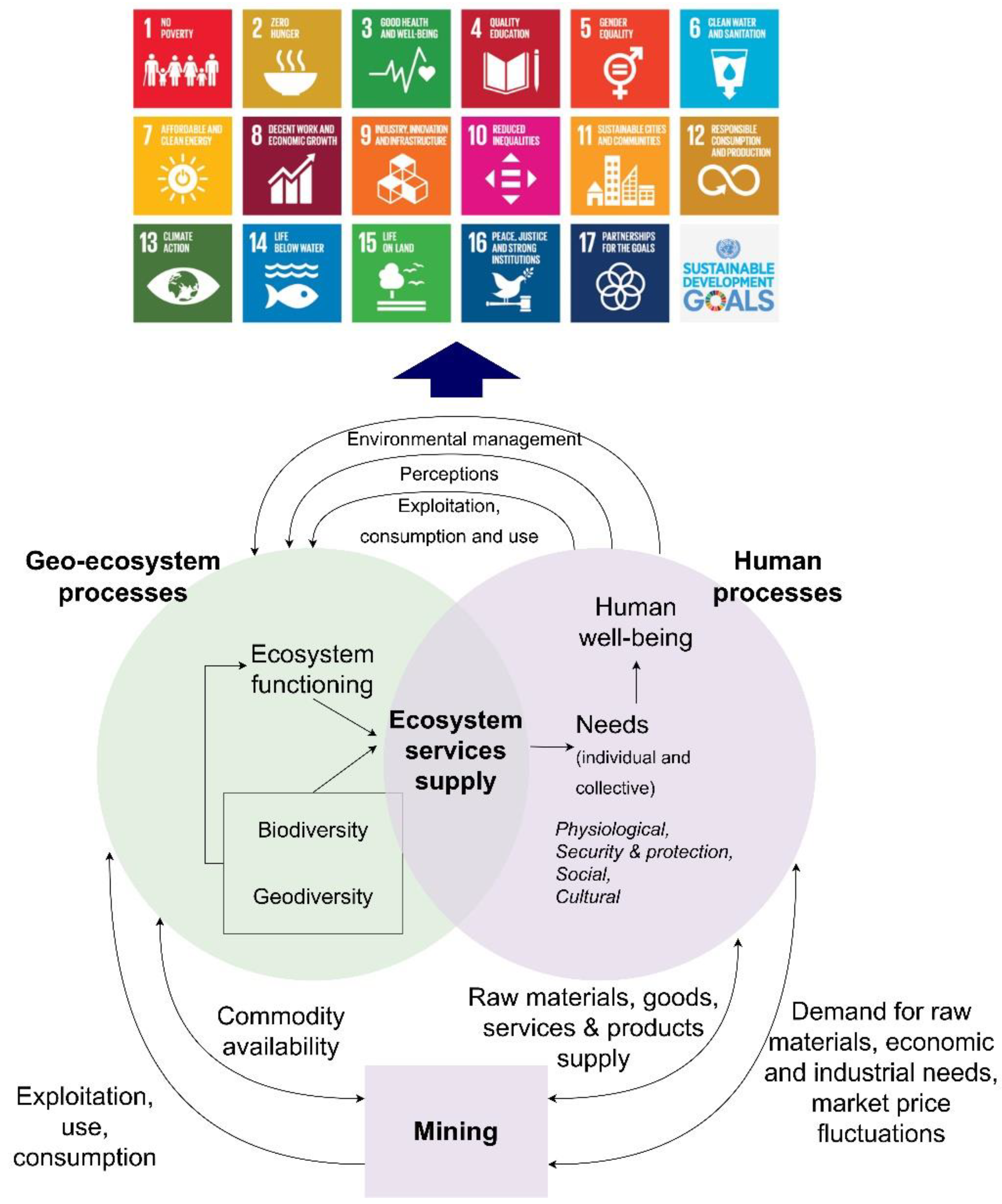
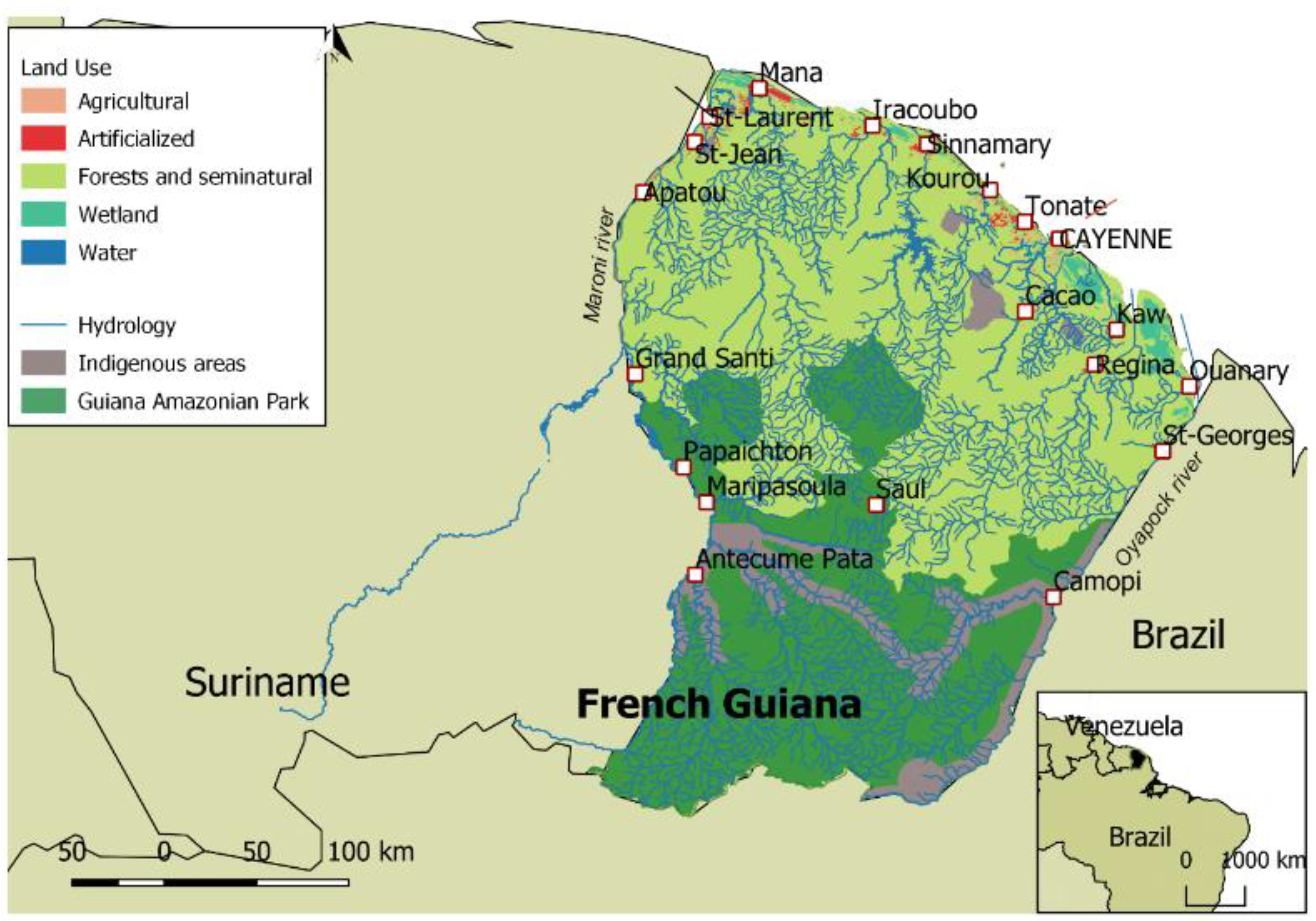
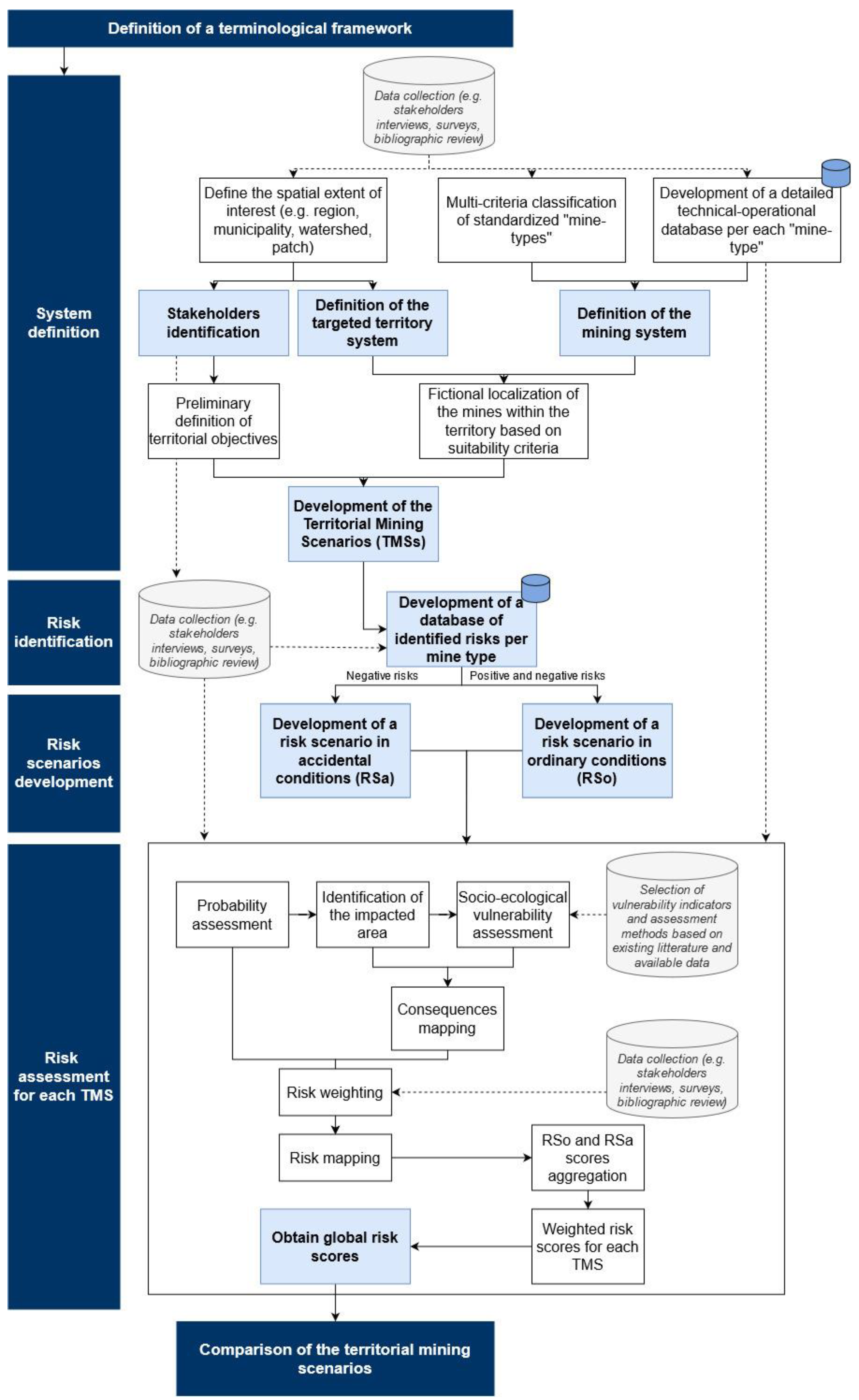

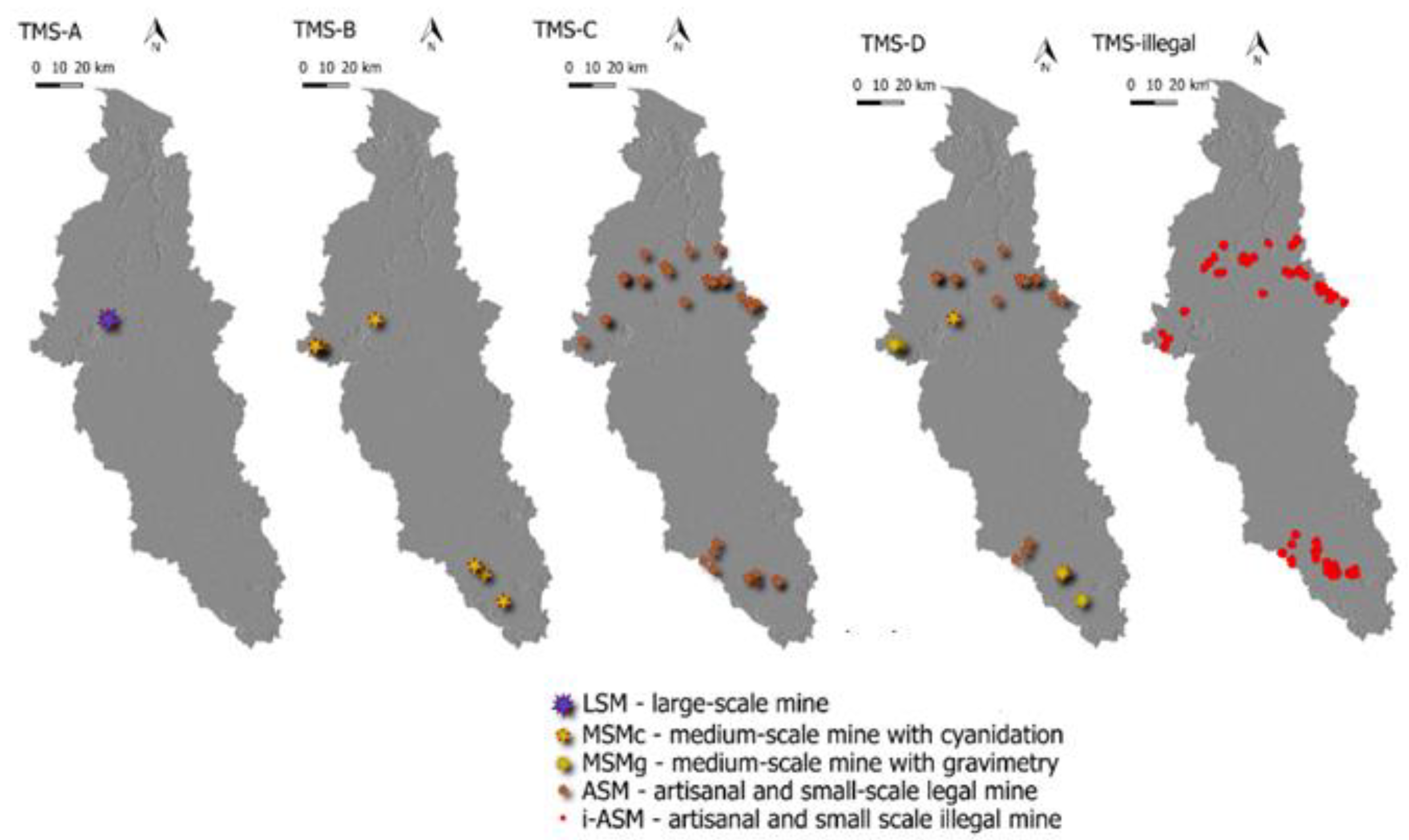
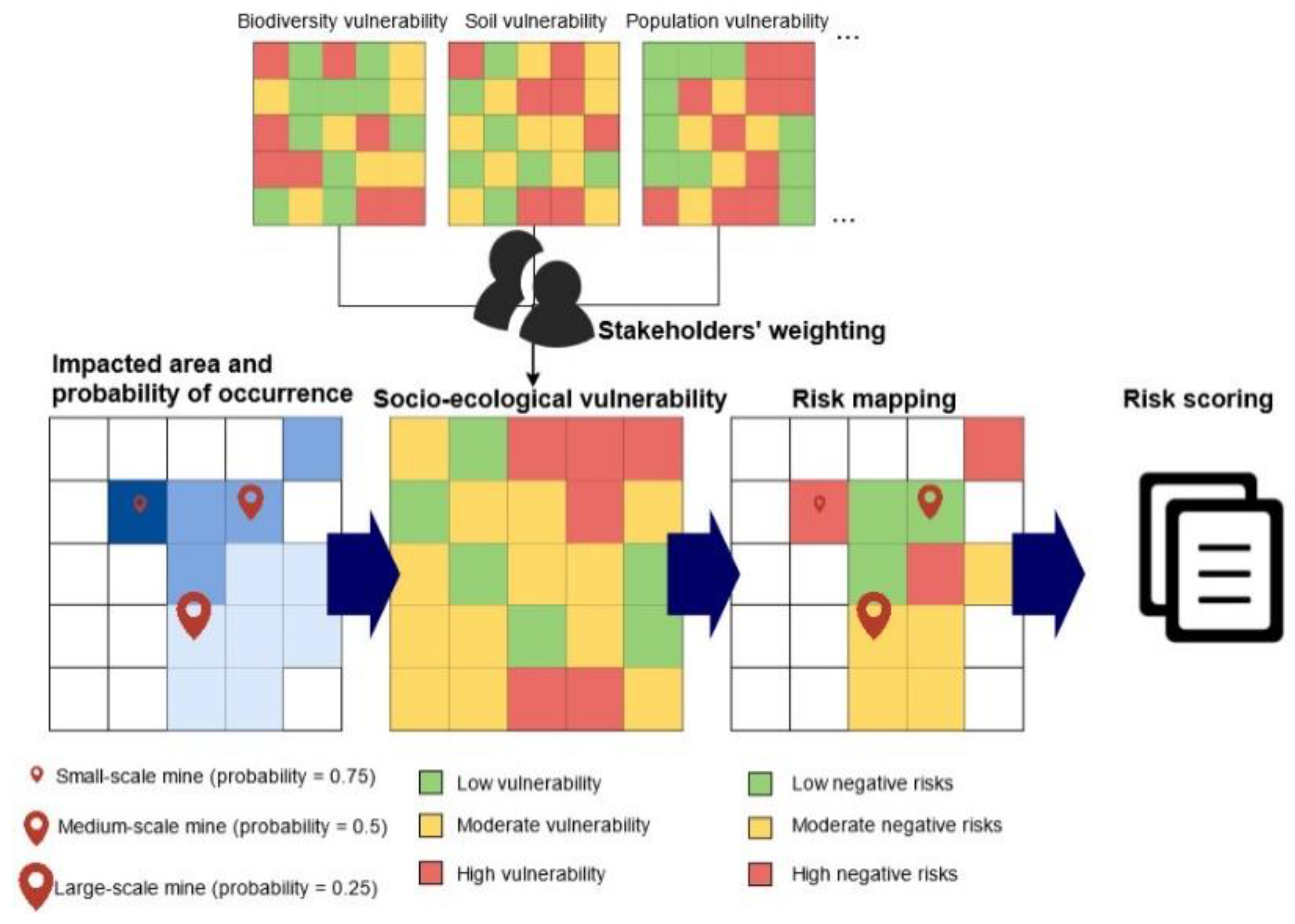
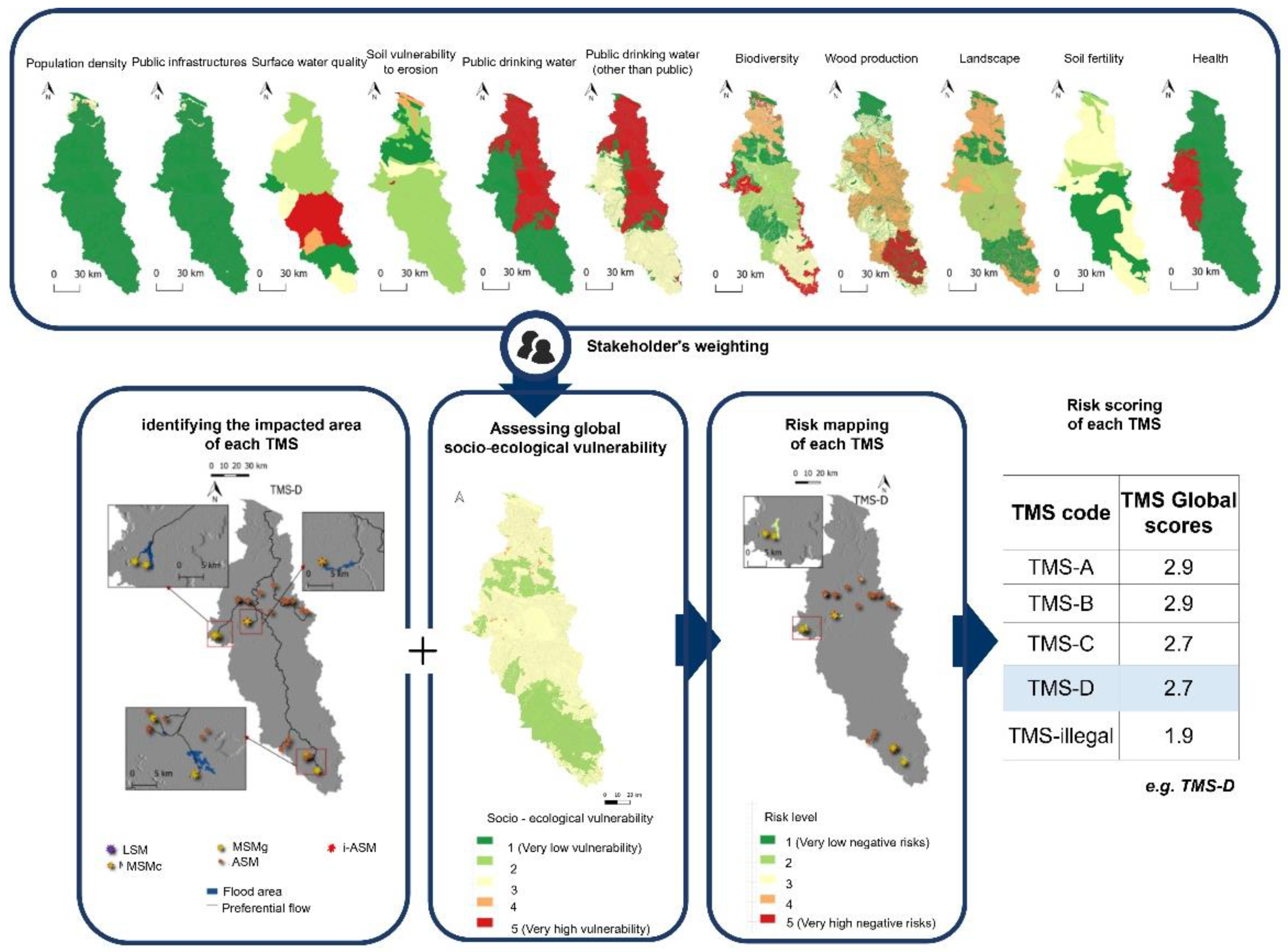
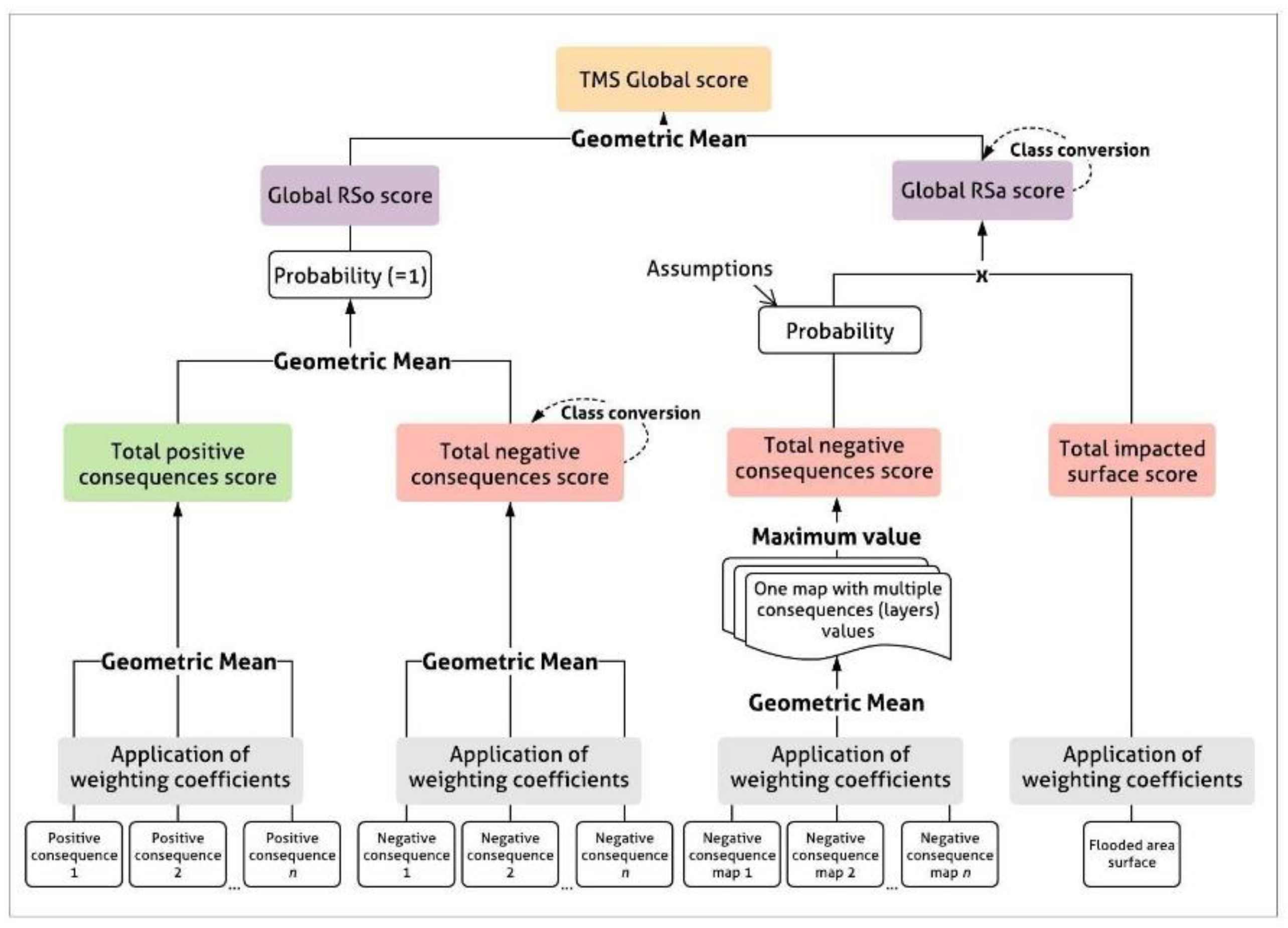
| Considered Characteristics | Gold Mining Project Types [40] | ||||||
|---|---|---|---|---|---|---|---|
| Features | Unit | i-ASMp | i-ASMs | ASM | MSMg | MSMc | LSM |
| Annual gold production | kg Au | 6.6 a | 150 | 300 | 800 | 5 | |
| Direct jobs | n | 10 a | 15 | 75 | 200 | 500 | |
| Soil footprint | ha | 20 a | 100 | 300 | 300 | 550 | |
| TSF b height | m | n/a | n/a | 4 | 15 | 20 | 54 |
| TSF storage capacity | Mm3 | n/a | n/a | 0.5 | 1.5 | 2 | 100 |
| Total royalties c | € | 0 | 0 | 125,611.5 | 251,223 | 669,928 | 4,187,050 |
| Territorial Objective | Required Number of Each Project Type for Each Territorial Mining Scenario (TMS) | |||||||
|---|---|---|---|---|---|---|---|---|
| Annual Gold Production (kg/Year) | Scenario Code | i-ASMp | i-ASMs | ASM | MSMg | MSMc | LSM | |
| 5000 | → | TMS-A | 0 | 0 | 0 | 0 | 0 | 1 |
| 5000 | TMS-B | 0 | 0 | 0 | 0 | 6 | 0 | |
| 5000 | TMS-C | 0 | 0 | 33 | 0 | 0 | 0 | |
| 5000 | TMS-D | 0 | 0 | 20 | 4 | 1 | 0 | |
| 5000 | TMS-illegal | 758 | 0 | 0 | 0 | 0 | ||
| Risk Scenario | Type of Consequences | Consequences at the Territorial Scale | Consequence Indicator |
|---|---|---|---|
| RSo | Positive | Raw material supply | Annual gold production (kg/yr) |
| Direct jobs opportunities | Number of miners or Total direct jobs/Annual gold production ratio | ||
| Expansion of social infrastructures (e.g., roads, energy, services) | Total royalties (k€) | ||
| Support of local education, research and skill development | Total royalties (k€) | ||
| Negative | Landscape degradation and deforestation | Topographic footprint of the mine site (ha) | |
| RSa | Negative | Destruction of the dam | Dam cost |
| Direct death and injuries of workforce | Maximal n° of workers at mine site | ||
| Destruction of mining infrastructures | Total CAPEX | ||
| Direct impact on local population | Population density per land-use type | ||
| Degradation of public infrastructures (buildings, roads) | N° and type of buildings and roads | ||
| Reduction of surface water ecosystem services | Expert-based ecological and chemical status of surface water | ||
| Run-off and soil degradation | Soil permeability | ||
| Reduction of public drinking water provisioning service | N° of people dependent from the public water points | ||
| Reduction of drinking water provisioning service (other than public) | Number of households without available public drinking water [80] | ||
| Reduction of biodiversity-related ecosystem services | Biodiversity potential [81] | ||
| Reduction of forest-related ecosystem services (wood production) | Wood quality [81] | ||
| Reduction of esthetic ecosystem services (landscape degradation) | Landscape quality [81] | ||
| Reduction of crop production service | Soil agronomic potential | ||
| Health Impacts | Typhoid vulnerability [80,82] | ||
| Social struggle | Avg. worker salary (= potential loss of incomes for local families) | ||
| Social opposition | N° of participants in opposition groups | ||
| Public sanctions | Maximal sanctions stated by law | ||
| Financial loss for the operator | n/a |
| Probability Scores | ||||||
|---|---|---|---|---|---|---|
| RS | Assumptions | i-ASM | ASM | MSMg | MSMc | LSM |
| RSo | Certain occurrence of all the events | 1 | 1 | 1 | 1 | 1 |
| RSa | Overall higher probability of occurrence of the event (worst scenario) | 1 | 0.75 | 0.5 | 0.5 | 0.5 |
| Classification Thresholds | Scenarios | Flooded Area (km2) | Class | ||
|---|---|---|---|---|---|
| Class | Flooded Area Range (km2) | ||||
| 1 | <1.00 | TMS-A | 227.76 | 5 | |
| 2 | 1.00–5.00 | TMS-B | 32.89 | 3 | |
| 3 | 5.01–50.00 | TMS-C | 4.35 | 2 | |
| 4 | 50.01–100.00 | TMS-D | 22.71 | 3 | |
| 5 | >100.00 | TMS-illegal | 35.76 | 3 | |
| Number of Each Project Type for Each Territorial Mining Scenario (TMS) | Risk Scenario Scores (1 to 5) | TMS | ||||||
|---|---|---|---|---|---|---|---|---|
| TMS Code | I-ASM | ASM | MSMg | MSMc | LSM | RSo | RSa | Final Scores (1 to 5) a |
| A | 0 | 0 | 0 | 0 | 1 | 2.2 | 3.8 | 2.9 |
| B | 0 | 0 | 0 | 6 | 0 | 1.8 | 4.5 | 2.9 |
| C | 0 | 33 | 0 | 0 | 0 | 1.7 | 4.4 | 2.7 |
| D | 0 | 20 | 4 | 1 | 0 | 1.8 | 4.1 | 2.7 |
| Illegal | 758 | 0 | 0 | 0 | 0 | 1 | 3.8 | 1.9 |
Publisher’s Note: MDPI stays neutral with regard to jurisdictional claims in published maps and institutional affiliations. |
© 2022 by the authors. Licensee MDPI, Basel, Switzerland. This article is an open access article distributed under the terms and conditions of the Creative Commons Attribution (CC BY) license (https://creativecommons.org/licenses/by/4.0/).
Share and Cite
Scammacca, O.; Mehdizadeh, R.; Gunzburger, Y. Territorial Mining Scenarios for Sustainable Land-Planning: A Risk-Based Comparison on the Example of Gold Mining in French Guiana. Sustainability 2022, 14, 10476. https://doi.org/10.3390/su141710476
Scammacca O, Mehdizadeh R, Gunzburger Y. Territorial Mining Scenarios for Sustainable Land-Planning: A Risk-Based Comparison on the Example of Gold Mining in French Guiana. Sustainability. 2022; 14(17):10476. https://doi.org/10.3390/su141710476
Chicago/Turabian StyleScammacca, Ottone, Rasool Mehdizadeh, and Yann Gunzburger. 2022. "Territorial Mining Scenarios for Sustainable Land-Planning: A Risk-Based Comparison on the Example of Gold Mining in French Guiana" Sustainability 14, no. 17: 10476. https://doi.org/10.3390/su141710476
APA StyleScammacca, O., Mehdizadeh, R., & Gunzburger, Y. (2022). Territorial Mining Scenarios for Sustainable Land-Planning: A Risk-Based Comparison on the Example of Gold Mining in French Guiana. Sustainability, 14(17), 10476. https://doi.org/10.3390/su141710476






